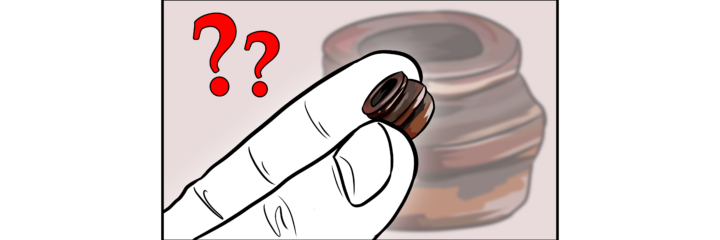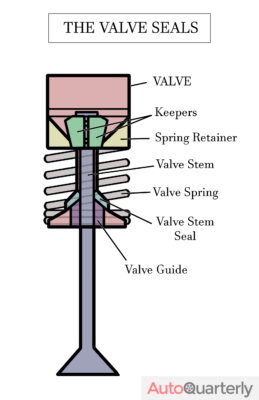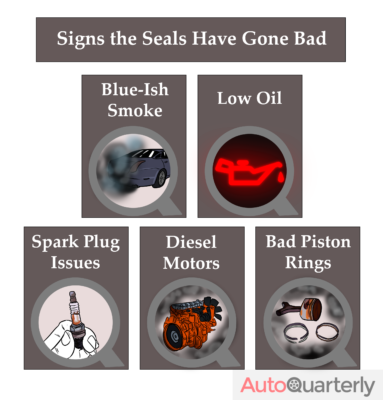Your car probably has valves. It probably has somewhere between 6 and 32, in fact. These valves are one of the most important parts of a four-stroke engine, and if they start misbehaving, it can lead to poor engine performance. No one has time for bad performance.
In this article, we’ll be talking about what happens when the valve seals go bad. Most people probably have never interacted with valve seals, so we will start by talking about what they are and what they do. After that, we’ll go over the symptoms you’ll experience when the seals go bad. Finally, we’ll talk about how to solve the problem.
How Valve Seals Work
In this section, we will run through the basics of how the valves in your engine work and what the valve seals are. If you prefer to learn things visually or want a lot more information that we can fit into this article, Autoblueprint has a really comprehensive explanation on this web page.
Engine Overview
There are going to be two sections of this quick overview. The first is simply going to be a glossary so that the rest of the article is easier to follow. The second will be an overview of how a four-cycle engine works.
The Major Parts of an Engine
The following list is by no means comprehensive, but it’s an ok overview.
- The block: the block is the chunk of metal that is the skeleton of the motor.
- The crankshaft: the crankshaft is a special shaft that can turn linear force into rotational force
- Connecting rods: the rods connect the piston to the crankshaft
- Pistons: the piston is a cylinder-shaped chunk that seals against the cylinder walls and creates the bottom of the combustion chamber.
- Cylinder: the cylinder is the cylindrical opening in the block that houses the piston
- Heads: the heads are bolted to the block and house the valvetrain, spark plugs, and other components
- Valves: valves inside the head open and close in order to let in air and fuel or let exhaust out
- Camshaft: the camshaft is a lobed shaft that either directly or indirectly pushes on the valves to open them at a specific time
- Valve spring: the valve spring closes the valve after the camshaft opens them
How an Internal Combustion Engine Works
The four-cycle engine, as the name implies, has four separate phases. We’ll explain them quickly, but if you like to watch videos rather than read, we have found that old animations are the best way to understand the process.
The four cycles are intake, compression, combustion, exhaust. It can be remembered easily as “suck, squeeze, bang, blow.”
- On the first downstroke, the piston moves away from the head and creates a vacuum, intaking the air and the fuel through the intake valve.
- On the first upstroke, the piston compresses the air and the fuel against the closed valves.
- The fuel and air combust, either from pressure or because of a spark from a spark plug, and the piston begins its second downstroke. The combustion pressure forces the piston down, so this stroke is known as the “power stroke.”
- The piston moves up for its final upstroke and pushes the burned fuel and air, called exhaust, through the exhaust valve and out of the car.
The Valve Stem Seals
Hopefully, the above sections have given you an ok idea of what the valves do. They are parts that are inside the engine that open and close at specific times. Almost everything in the engine is covered in oil. The only place you don’t want oil is inside the combustion chamber during combustion, which could be an issue since the valves have to open into the combustion chamber.
To prevent oil from dripping into the combustion chamber when the valves are open, a reinforced rubber ring wraps around the valve stem and seals the top of the motor against the combustion chamber. These are the valve stem seals or just valve seals for short.
Signs the Seals Have Gone Bad
Now that you know how they work, identifying the symptoms of a failed seal is fairly easy. The valve seals prevent oil from entering the combustion chamber. If they are not performing their job, oil ends up where it shouldn’t.
You’ll probably notice it in one of three ways.
Smoke
When oil burns, it smokes a lot. That means if it ends up in your combustion chamber, your exhaust will contain a lot more smoke than usual. You will be able to see it when it exits your vehicle.
However, when your car is running, it can be difficult to see the smoke. The times you will notice it most are after the car has been sitting and oil has managed to build up. That means when you first start the car, when you idle in traffic, or when you are going downhill. If you have a bad valve stem seal during those times, you will notice blue-ish smoke coming out of the tailpipe.
Low Oil
This is probably the most straightforward symptom. If your engine is burning oil, the oil level is going to drop. Your car likely has a low oil light or an oil pressure warning light. Those will illuminate when your oil gets low. Although, it’s better to regularly check your engine oil so that you can identify problems before warning lights come on.
Spark Plug Issues
The oil in the combustion chamber will foul and destroy the spark plug. Fouled plugs don’t work as well as clean plugs, and you can read about the issues that bad spark plugs will cause here. If you notice any symptoms of a bad spark plug, or notice any of the above symptoms, simply pulling out one of the plugs and checking it for oil is the easiest way to confirm your suspicions.
Diesel Motors
If you own a diesel, though, you don’t have spark plugs. You will probably also smoke a lot on startup, even if the motor is very healthy. That can make it very difficult to notice oil in the combustion chamber, and you may only see signs when you go in for an oil change, and you are a few quarts low.
Bad Piston Rings

If your piston rings go bad, you can experience exactly the same symptoms because the same thing is happening. Oil is ending up in the combustion chamber; it’s just from below instead of above. Generally, if you first start the car and notice smoke, but the smoke goes away after a while, it’s the valve seals and not the rings. The rings will cause smoke whenever you accelerate, not just during startup.
While smoke is a great way to tell if your engine is having issues, if you live in a cold climate, you’re going to notice smoke when you start your car. This is simply a temperature issue. If the smoke goes away after a few minutes of running, or slows down, you don’t have to worry. Another way to distinguish oil-based smoke from cold-start smoke is the color. Cold start smoke is white, while oil-based smoke is tinted with blue.
The only way to be sure is to replace the valve seals and see if the problem goes away, or you will have to perform what is known as a leak down test. Mobile Oil Company has a good overview of the leak down test.
Is It Safe to Drive With Bad Seals?
It is safe to drive with bad seals. It’s not good for your engine, and prolonged issues will cause other problems. The most expensive problem that bad valve seals can cause is the destruction of your catalytic converter. Burning oil will clog the converter, and catalytic converters can cost upwards of $1,000.
However, if you are on a budget or lack time, it won’t hurt anything to drive around for a while with bad valve seals. Just make sure to keep the oil topped up. Running out of oil will destroy your engine.
Replacing Your Valve Seals

Replacing the valve seals is a very involved process. You will need a large collection of hand tools, some specialty tools, and a lot of time. One of the steps in replacing the valve stem seals is removing the valve springs from the motor. It’s not an easy process.
If you need to have your valve seals replaced, you have three main options. The right option for you will depend largely on what tools you have available and how much time you have.
Taking the Car to a Mechanic
A good mechanic can replace the seals in half a day if the shop is not busy. It’s a very labor-intensive process. However, the parts are cheap, and it doesn’t require any special knowledge. Expect to pay about $50 in parts depending on how many valve seals need replacing.
Shop rates in the US tend to be between $75-150, so you should budget at least $800 if you plan on having a mechanic perform this service.
Do It Yourself
There are a lot of parts between the outside of the engine and the valve seals, and some of the processes can be difficult. You can watch this video to see what you are up against.
You will need the following items:
- Torque wrench
- Spring compression tool
- A complete socket set
- A complete wrench set
- Containers to hold parts
- A Torx set
- A screwdriver set
- A magnet tool
- A service manual for your car. That’s probably the most important thing.
Head Removal
Doing a valve rebuild is easier if the heads are off the motor. That way, you can access both sides of the valve and hold it in place as you work on it. You can also set the head on a workbench so that you don’t have to work on the valves while hunched over your engine bay.
However, removing the head is one of the most labor-intensive things you can do when working on a motor. It adds a layer of complexity and challenge to an already challenging process. Whether or not it’s worth it will depend on how you feel. If you can feel your back start hurting when you think of bending over and compressing springs, really consider taking the extra 30 minutes to pull the head.
Tips, Tricks, and Dangers
Here are some tips and tricks that will help you with the process. Some are general tips for working on a car, and some are valve specific. Chances are good that if you feel comfortable enough to attempt this job, most of these tips will just be gentle reminders rather than eureka moments.
- Label everything, and keep separate parts in separate containers. When you go to put the engine back together, you will thank your past self for staying organized.
- Follow the loosening and tightening patterns. You can damage very expensive parts if you don’t.
- Use paint pens to make alignment marks. That way, you don’t have to find TDC when you assemble the motor.
- Make sure the bolts and guides get put back in the same space.
- Be careful with spring tools. If they slip, the spring can expand very quickly. It hurts if it hits your finger.
- If you do pull the head, it’s a good idea to replace the gasket even if you don’t see any damage.
- Visually inspect everything as you go. Opening the motor up is a rare process. Take the opportunity to give everything a look-over and you might be able to stop problems before they happen.
Send the Head to a Mechanic
This option is in-between a full DIY valve train rebuild and a simple valve seal replacement. If you are replacing the valve stem seals, you may want to put in some extra work and money to refresh the entire head. It costs about $1,000 for most cars, and you will have to either pay to remove the head or remove it yourself.
A shop that specializes in rebuilding heads can do all the hard parts for you. They’ll adjust the clearances, lap the valves, and replace all the seals and bearings. They can even do specialty services to make your engine produce more power, like install bigger valves, different springs, and polish the head.
End Excessive Oil Consumption
Burning oil is bad for the wallet and bad for the air. That smoke doesn’t belong in your lungs and buying a quart of 5w30 every other day can quickly get expensive. We hope this guide can send you down the right path towards solving the problem. Whether you have the know-how to do it yourself or take the car to a shop, you now have the information necessary to stop unnecessary oil consumption.




